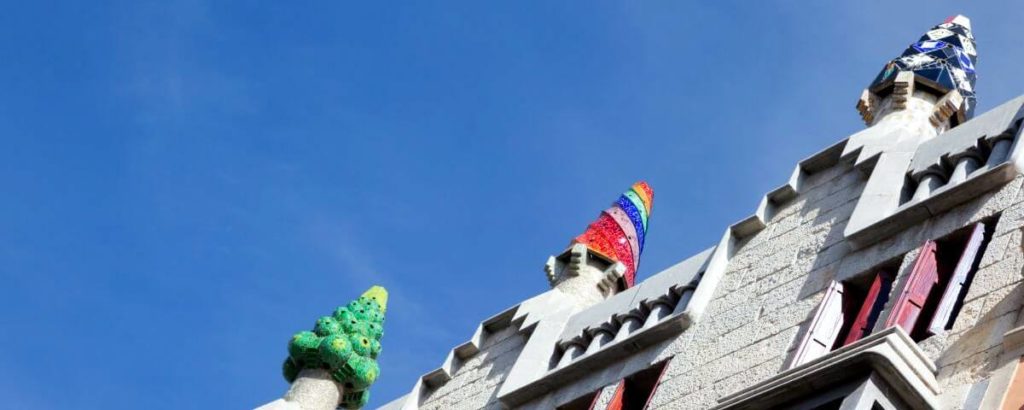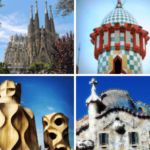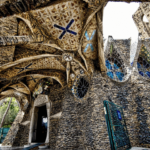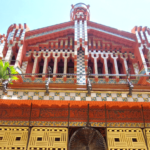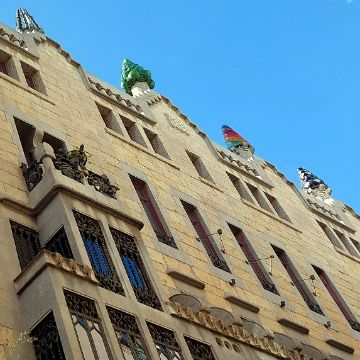
Visiting Gaudi’s Palau Guell interior
ALL ABOUT THE INSIDE OF PALAU GUELL IN BARCELONA
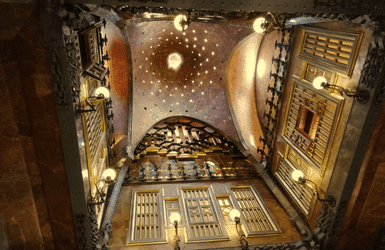
Gaudi worked for the Count Guell many times, but Palau Guell can be considered the first important project they did together, way before even Park Guell. It is the first time that the Count entrusts him with a complex commission, not just a small thing like a gate here or a pergola there. Palau Guell is also Antoni Gaudi's only building in the old town of Barcelona, eve if not the only "project", because very close to Palau Guell, in the nearby Plaça Reial, there's two streetlights also designed by Gaudi.
The owner of Guell Palace and Antoni Gaudi
1
Antoni Gaudi and Eusebi Guell
Eusebi Guell was the second richest person in Spain, second to his father in law, the Marquis of Comillas. He was an extraordinary businessman and an educated intellectual with a visionary open mind. He met Antoni Gaudi in 1878, after seeing a piece of furniture designed by the architect that won an award in the Universal Exhibition in Paris. They soon became best friends, and the Count started hiring him for small projects at first, and bigger enterprises.
When Guell’s father passed away, he inherited two family properties in La Rambla, which until the construction of the Eixample district had been the residential area of the local high society. Eusebi Guell decided then to purchase the neighboring plots with the idea of extending the mansions, but eventually asked Gaudi to build a new one from scratch facing the rundown Raval district instead of the main street. The mansion was completed in 1888.
It was an unusual choice, because the rest of the upper class was already moving to the Eixample, and because Guell thought that having his elegant visitors to go through the poor neighborhood might help rising the area vibes and hopefully improve it. A quite forward thinking idea that the Barcelona city council copied for the Olympic Games by opening up university faculties in degraded neighborhoods to attract young students and help improving the district.
Visiting the Palau Guell interior
2
Entrance Hall and Basement of Palau Guell
You’ll enter the street level of Palau Guell through a magnificent arch decorated with an intricate wrought iron lattice. After passing security you’ll enter an open space that is basically the U-turn for the horse carriages, that would exit through a twin arch next to the one you just crossed. From there you’ll see a spiraling ramp that goes down to the basement (now closed to the public due, as the structure is too delicate to endure hundreds of visitors every day)
3
Palau Guell main floor
After visiting the street level and the basement, you’ll find a grand staircase between the two entrance arches: follow it to reach the main floor. The visit of this level can be a bit confusing. Rather than following the hallway that runs along the façade windows, take first the corridor in the opposite direction. It’ll take you first to the sitting rooms where the Guell family entertained their guests (don’t miss the engraved leather sofa) and a luxurious dinning room complete with the original furniture.
The same path will also take you to the backyard, from where you can admire the back side of the mansion, decorated with an Asian-looking pergola that protected Ms. Guell from the sun when she accessed her balcony. In the opposite end of the backyard you can access the play room, with a vintage pool table and a door that will allow you to see the details of the dinning room fireplace from closer.
Now you can retrace your steps back to the staircase, and follow the “hall of the lost steps”, with the arched windows and many columns that allowed the light in, and still protecting the residents privacy and hiding the unpleasant views (the building across the street was a brothel…). Don’t enter the main hall yet: go all the way to the end of the passage way to the waiting room.
You’ll have to imagine the lavish decoration that would have been there, to match the intricate wooden ceiling dotted with real precious gems. The powder room in the other end was used by the ladies while waiting. A secret passage around the room decorated with a geometric wooden lattice allowed the maids to spy on the waiting guests so they could report to Count Guell before they were received.
Now you can go back and enter the main room, whose ceiling is a marvelous hyperboloidal dome with small opening simulating a starry night. Here the Guell threw public receptions, parties with ballroom dancing (the band stood on the staircase that leads to the upper floor) and even private mass, as two massive metal doors hide a small chapel with side benches for the family. The kids would play the organ (one of the largest in the world in those times) for the guests.
4
Upper floor of Palau Guell: the private quarters
But before you visit them, head instead towards the inside part of the building to see Ms. Guell’s private quarters. She had her own living room, decorated with a monumental fireplace topped with an image of her patron saint, Saint Elizabeth (her maiden’s name was Isabel Lopez of Comillas). She had also a dressing room, balconies overlooking the main room, and her own bedroom with the balcony under the pergola you saw from the backyard.
One iconic piece of furniture by Antoni Gaudi decorated the house: a chaise longue that continues to be owned by the Guell family and only rarely is loaned for public art shows. A couple of black and white pictures on display will help you get the idea of how the room looked like when she lived there.
The room is connected from one end with her husband’s bedroom: in a time when arranged marriages were the norm, it wasn’t unusual that the spouses didn’t share the same bed except for fulfilling their marital obligations… To see that room you’ll have to walk around the shaft of the main room – my recommendation is that you see the children rooms first, then see their fathers’ room. This one, though, lacks of decoration and it’s quickly seen. Of course, he didn’t need much: after all, he was the owner of the entire building!
The corridor takes you next to the bathroom (devoid of bathtubs and other props now), and a toilet room with a toilet seat overwhelmingly decorated in blue oriental patterns. There’s also one more children’s room, where now a video is displayed, before you retrace your steps back to find the service stair that will lead you upstairs.
5
Palau Guell rooftop and attic
The rooftop terrace of Guell Palace can be considered the first of the iconic Gaudi rooftops: a magical place with colorful chimneys of fantastic shapes. Sure, in Casa Vicens Antoni Gaudi also topped the house with a statement tower, but the rest of the rooftop doesn’t have the extravagancy that will have his other projects. And while the rooftop of Torre Bellesguard hides a giant dragon, at a first sight it’s not that outstanding either.
Besides the chimneys covered in mosaic tiles (many of them a modern restoration), in the center of the terrace rises a conic tower covered in stone and ceramic oven leftovers: it’s the central skylight that grows on top of the main hall dome. The metal weather vane on top of it is a reference to the Catalan Counts, and a way to honor Count Guell’s newly awarded heraldic title. After admiring the views, the same service stair that took you here will lead you all the way back to the exit of the building.
Planning your visit to Palacio Guell
6
Guell Palace address, opening hours and more
Address: Nou de la Rambla 3-5 (Barcelona, Spain)
Closest subway stations: half way between Drassanes and Liceu on L3 (green line – some 4 minutes walk), and 7 minutes walk from Paral·lel on L2 (pink line)
Website: https://www.palauguell.cat/
Opening hours: From 10AM to either 5.30PM (winter season) or 8PM (summer season). Closed on Mondays.
RESEARCHING FOR A TRIP IS TIME-CONSUMING…
Need more inspiration?
Our 100% FREE Barcelona Collection will give you everything you need to organize the trip of your lifetime to Barcelona.
BEST INSIDER TIPS FROM THE PROS!

Last update on 2024-04-20 / Affiliate links / Images from Amazon Product Advertising API

